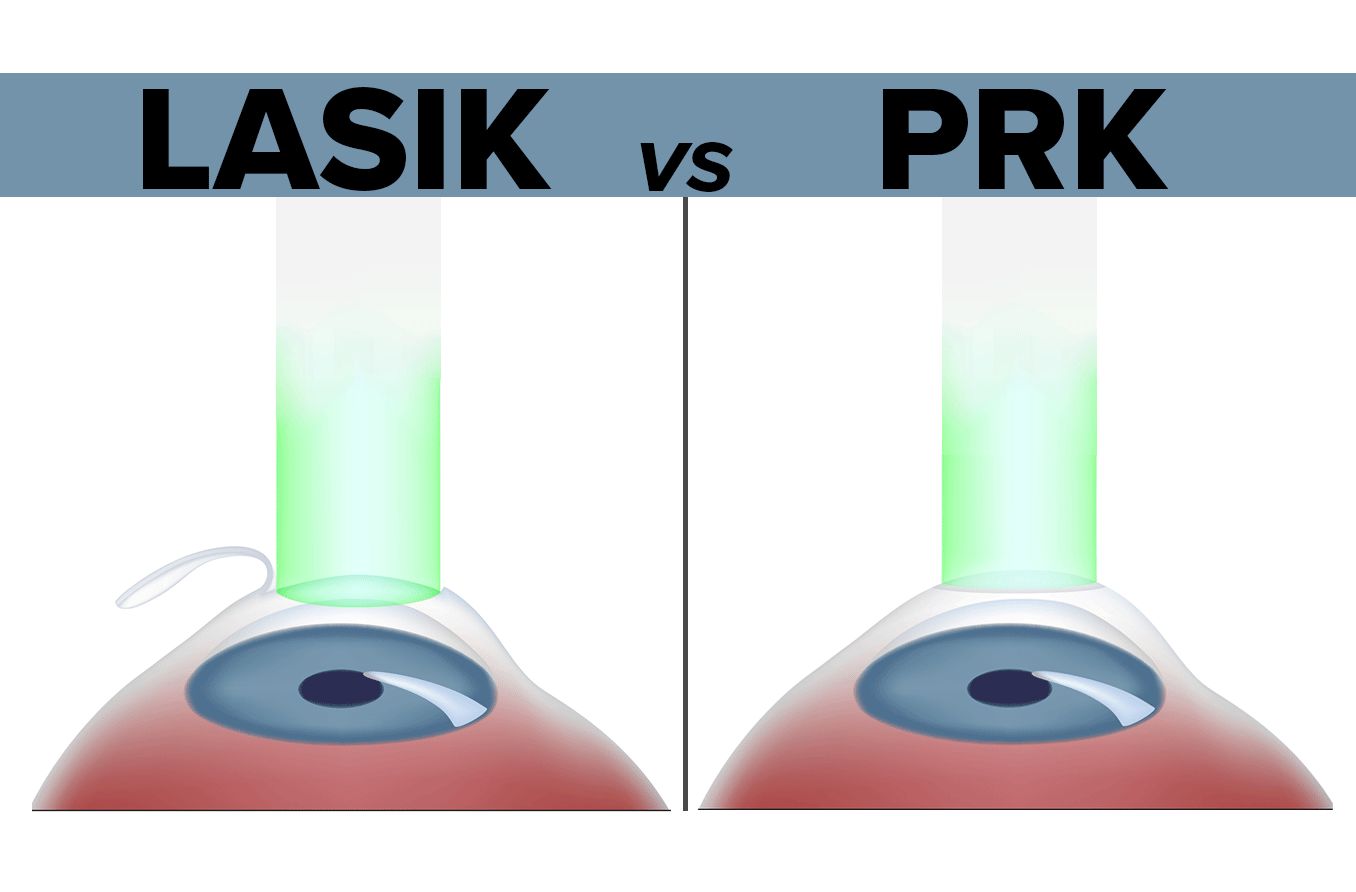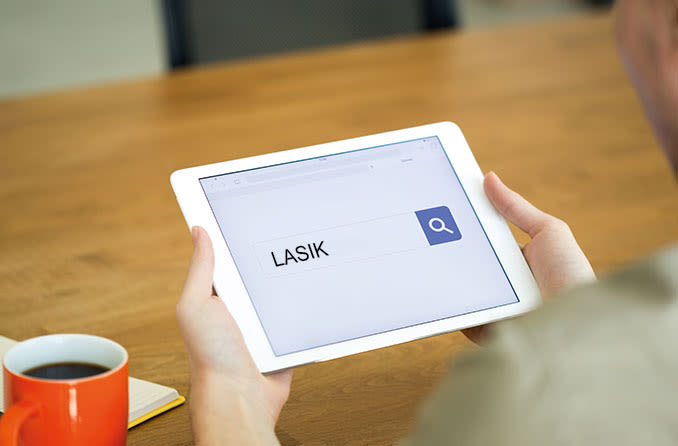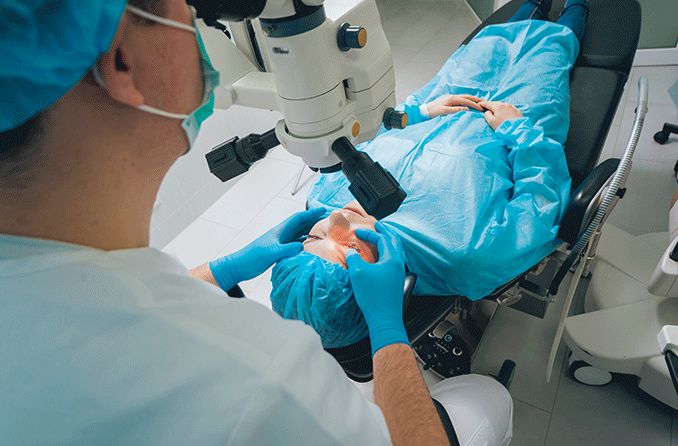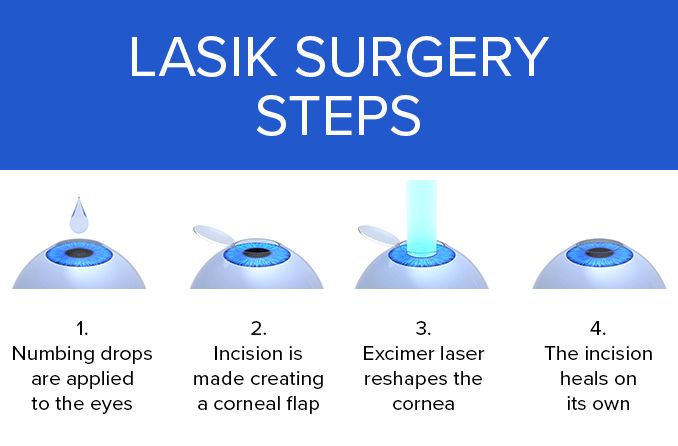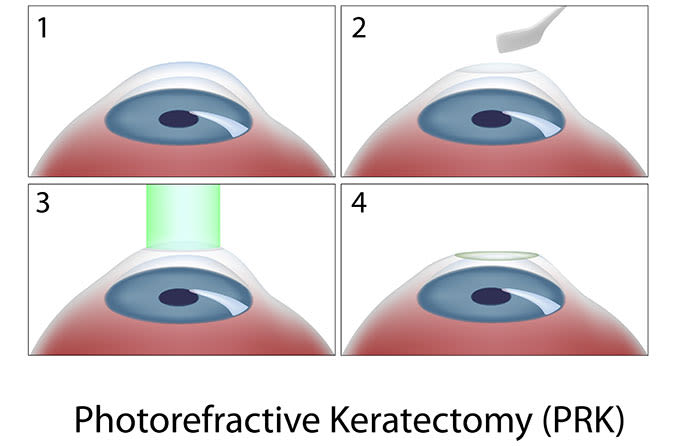If you’re looking to get rid of contact lenses or glasses, you may be weighing the pros and cons of PRK vs. LASIK to decide which type of laser eye surgery would work best for you.
Both PRK and LASIK can be used to treat refractive errors in vision, including astigmatism, nearsightedness (myopia), farsightedness (hyperopia) and presbyopia, a condition common after age 40 that can make it harder to see when doing close-up tasks like reading.
Learn how PRK (photorefractive keratectomy) compares to LASIK (laser-assisted in situ keratomileusis) in terms of cost, surgical technique, recovery time, pain, complications and side effects. This guide also covers PRK vs. LASIK for military, law enforcement and other professions that may require excellent vision.
PRK vs. LASIK eye surgery cost
Price is one factor to consider when comparing types of eye surgery. PRK is often considered to be a bit cheaper than LASIK, but AllAboutVision.com surveys found similar average costs.
Here’s a breakdown of the average cost of PRK vs. LASIK:
The average cost of LASIK in 2020 was $2,246 per eye or a total of $4,492 for both eyes, according to a report on the cost of LASIK in the United States, created for AllAboutVision.com by market research firm Market Scope.
The average cost of PRK was $2,300 per eye or a total of $4,600 for both eyes, according to a survey by AllAboutVision.com of laser eye surgery centers that offer upfront pricing. However, LASIK may cost several hundred dollars more per eye than PRK at certain eye centers.
Keep in mind that costs can vary widely based on the geographic location and the surgeon. Contact the eye surgery centers you’re considering, and ask about pricing to get accurate cost information for laser eye surgery near you. You also may be able to get financing for LASIK or PRK surgery.
PRK vs. LASIK: surgical techniques
Both PRK and LASIK are outpatient procedures that will involve spending about an hour at the eye surgery center. For both procedures, the surgeon will put anesthetic eye drops in your eye and use an eye speculum to hold your eyelids open during surgery.
There are some differences as well. Here’s a contrast of PRK vs. LASIK in terms of surgical technique:
LASIK involves creating a flap while PRK does not. In LASIK, the doctor uses the laser to create a flap in the cornea to access and reshape the cornea to correct your vision. The surgeon places the flap back in place to heal.
PRK involves removing the outer layer of the cornea while LASIK does not. In PRK, the surgeon removes the outer layer (epithelium) to reshape the cornea. The outer layer of the cornea grows back after surgery. The surgeon inserts a soft contact lens to act as a bandage during healing.
Both types of surgery require you to have someone drive you home because you will not be able to see clearly immediately afterward.
PRK vs. LASIK: recovery and healing time
LASIK typically has a much shorter recovery time than PRK. The initial recovery time for PRK lasts about two to three days, while with LASIK you can typically go back to work the next day.
There is little to no pain during recovery with LASIK, while about 10% of PRK patients may experience “mild to moderate” pain or discomfort in the 24 to 36 hours after surgery. This pain may be managed with eye drops and oral pain relievers.
The length of time it takes to attain clear vision after surgery is much longer with PRK than with LASIK. It can take about a month to see clearly after PRK, while LASIK patients may be able to see clearly within a few hours to a few days.
Because it can take so long for the eye to heal fully after PRK, some surgeons prefer to do surgery on one eye and then do the procedure on the other eye a month or two later. With LASIK, doctors typically do surgery on both eyes in the same surgery session.
Are you a candidate for PRK or LASIK?
You generally need to be at least 18 to 21 years old and have healthy eyes and stable vision to be a candidate for PRK or LASIK. Patients with conditions such as glaucoma or severe dry eyes might not be candidates for laser eye surgery.
These are general characteristics of candidates for PRK vs. LASIK:
Candidates for PRK – May be older, have thinner corneas and lead active lifestyles
Candidates for LASIK – May be younger, have no eye issues and prefer less downtime
Your corneal thickness may determine whether you’re a candidate for laser eye surgery and determine which type of surgery you can get. In addition to PRK, patients with thinner corneas may also be candidates for another type of procedure such as epi-LASIK eye surgery, which is similar to LASIK but involves creating a thinner flap in the cornea. Another option, LASEK eye surgery, combines techniques from both PRK and LASIK.
PRK vs. LASIK: risks, complications and side effects
Both PRK and LASIK are considered safe and effective methods of laser vision correction. The risks, complications and side effects may vary by individual and procedure.
One study published in the journal Ophthalmology found that some PRK and some LASIK patients report worsening of glare, halo and double vision in one eye (monocular diplopia) after surgery while other patients reported improvement in these symptoms. The main differences the study found were:
PRK patients may be more likely to report an increase in halo and diplopia (but not glare)
LASIK patients may be more likely to report an increase in diplopia (but not glare or halo)
This doesn’t mean that any individual patient will necessarily see a worsening or improvement in these symptoms, but these statistics may provide a general idea of how PRK compares to LASIK in terms of side effects.
Another factor to consider: risk of complications. PRK is considered slightly less risky than LASIK because there is no risk of complications with the corneal flap since the procedure does not create a flap.
In LASIK, there may be a rate of flap-related complications of around 1% when the surgery is performed by an experienced eye surgeon. Flap complications may include the flap getting dislodged after surgery or tiny wrinkles (flap striae) in the cornea. Flap complications can typically be successfully treated by your LASIK surgeon if they occur.
PRK vs. LASIK: outcomes
PRK and LASIK both have similarly positive outcomes. Studies have not found any difference between PRK and LASIK in long-term outcomes in patients with low to moderate nearsightedness. And research has not shown either PRK or LASIK to be better for patients with farsightedness.
One difference is that after healing with LASIK, a flap still remains on the cornea. This means there is always a risk that blunt trauma could dislodge the corneal flap in the future. In the rare cases in which that happens, the patient may need surgery to reposition the flap.
In contrast, an eye that has healed from PRK goes back to the way it was before surgery. For this reason, some surgeons recommend PRK for people with very active lifestyles or professions such as law enforcement.
PRK or LASIK for military, pilots and law enforcement
There are certain career fields for which good eyesight is a job requirement. Therefore, people in military and law enforcement may have special considerations when deciding which type of laser vision correction to get.
PRK vs. LASIK for military: Laser eye correction is popular in the military because clear vision is key, and glasses and contact lenses may hinder job performance in certain scenarios. PRK is the most popular laser eye surgery for military members due to concerns that job-related trauma after LASIK could cause flap dislocation.
But LASIK does have advantages over PRK for military members, including faster recovery time and ability to return to work more quickly. Military members may be able to get back to full duty in six weeks with LASIK vs. three months with PRK. For that reason, both LASIK and SMILE laser eye surgery are becoming more common among members of the military. SMILE laser eye surgery may be a good option for military members because there is no flap to get displaced, and recovery time is similar to LASIK.
Before getting laser eye surgery, military members may want to check to see if corrective eye surgery could make them ineligible for a particular role in a certain military branch.
PRK vs. LASIK for pilots: LASIK has a few advantages for pilots over PRK, including minimal “central haziness” and the ability to get to 20/20 vision more quickly, according to the Aviation Medicine Advisory Service. Pilots should carefully consider any possible downsides to laser eye surgery, including possible worsening of night vision.
PRK vs. LASIK for law enforcement: Despite the longer recovery time, PRK may be a better option than LASIK for those in law enforcement due to the risk of the LASIK flap getting dislodged during training or physical contact on the job.
There is also a risk that pepper spray could get under the corneal flap and cause irritation. Police officers who get LASIK may need to wear eye protection at times to minimize these risks. LASEK may be another good option for people in law enforcement.
People in aviation, military or law enforcement who are considering PRK or LASIK should also be aware that it’s possible laser eye surgery will not correct their vision to the required standards of their profession. If you’re in one of these fields, this is an important topic to discuss with your eye surgeon.
The bottom line: pros and cons of PRK vs. LASIK
So, which is better, PRK or LASIK? It really all depends on the individual person. In summary, advantages of LASIK over PRK may include:
Ability to resume normal activities quickly
Little to no pain after surgery
Quicker results
The advantages of PRK over LASIK may include:
Slightly lower cost
Works better for some patients (active lifestyles, over 40, thinner corneas, higher prescriptions, certain professions)
There is no flap that could get dislodged in the future
However, the decision on whether to get PRK or LASIK will depend on your individual situation. Your eye doctor or eye surgeon will need to do a comprehensive eye exam and check your corneas to determine if you are a better candidate for PRK or LASIK. If you’re a candidate for both procedures, your eye doctor will discuss factors to weigh when making your decision.
If you’re ready to take the next step and set up a consultation, it’s time to choose an eye surgeon and schedule a visit.
